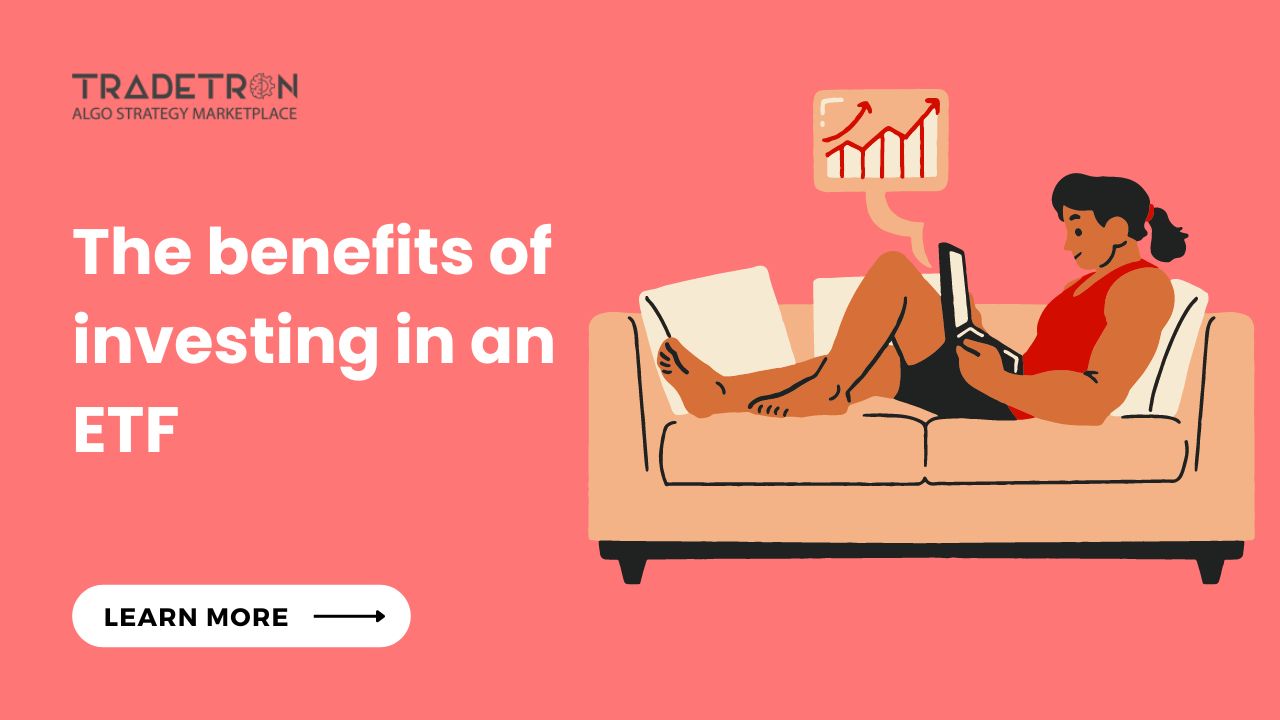Contents
Are you looking to expand your investment horizons but feeling overwhelmed by the seemingly endless options available?
Fear not, dear investor!
Today, we're going to explore one of the most popular and accessible investment choices: Exchange-Traded Funds (ETFs).
In this comprehensive guide, we'll demystify ETF meaning and ETF stock meaning while taking a closer look at how they work.
Also, we'll delve into their benefits and drawbacks as well as provide some valuable tips on choosing the right ETF for you.
So grab a cup of coffee or tea, sit back, and let's dive into the fascinating world of ETFs together!
ETF Meaning
ETF stands for Exchange Traded Fund. It is a type of investment fund that trades on stock exchanges, just like stocks.
ETFs are designed to track the performance of a specific index or group of assets, such as stocks, bonds, commodities, or currencies.
What is an ETF?

An ETF, or Exchange-Traded Fund, is a type of investment fund and financial product that allows investors to buy shares in a diverse collection of assets.
These assets can range from stocks and bonds to commodities and even entire market indices.
Unlike mutual funds, which are traded once per day at the end-of-day price, ETFs (Exchange-Traded Funds) are traded on stock exchanges throughout the trading day just like individual stocks.
One way to think about an ETF is as a basket of securities designed to track the performance of specific markets or sectors.
By investing in an ETF (Exchange-Traded Fund), you're essentially buying shares in this basket rather than trying to pick individual winners from numerous options.
This unique structure offers several benefits for both novice and seasoned investors alike.
Most notably, it grants instant diversification across various industries or asset classes while allowing for easy access through any brokerage account with minimal barriers to entry.
How does an ETF work?
An ETF, or an Exchange-Traded Fund, operates similarly to a mutual fund in that it pools together assets from multiple investors.
However, instead of being actively managed by a professional money manager, the ETF is passively managed and tracks a specific index.
For example, let's say you want to invest in technology stocks but don't have the time or expertise to manage your own portfolio.
You could buy shares of a technology-focused ETF (Exchange Traded Fund) that tracks the performance of major tech companies like Apple and Microsoft.
This allows you to gain exposure to the sector without having to pick individual stocks yourself.
ETFs trade on exchanges just like stocks do, which means their price can fluctuate throughout the day based on supply and demand.
Investors can buy or sell shares at any time during market hours.
One advantage of investing in an ETF is its low fees compared to traditional mutual funds.
Since they are passively managed and track indexes rather than trying to beat them, they require less oversight from professionals.
Understanding how an ETF works can help investors make informed decisions about whether it's right for their investment strategy.
The benefits of investing in an ETF

Investing in an ETF (Exchange-Traded Fund) can bring many benefits to investors.
One of the most significant advantages is diversification, as ETFs hold a basket of securities from different industries or sectors, minimizing risk and volatility.
This means that if one stock in the fund underperforms, it won't significantly impact your overall investment.
Another benefit is liquidity. ETFs trade on exchanges like stocks do, making them easy to buy and sell throughout the trading day at market prices.
They also have lower fees than mutual funds since their management costs are generally lower.
ETFs offer exposure to entire markets or specific sectors without requiring extensive research or knowledge about individual companies.
For example, you can invest in an energy sector ETF rather than buying shares of several energy company stocks separately.
Furthermore, investing in an ETF requires less capital compared to purchasing individual stocks outright.
With fractional shares available for some funds, investors can easily start building a diversified portfolio with smaller amounts of money.
Investing in an ETF provides a cost-effective way to gain exposure to various asset classes while reducing risks through diversification and benefiting from increased liquidity and affordability.
The drawbacks of investing in an ETF
Investing in ETFs is not without its drawbacks.
One of the main disadvantages is that investors have no control over the underlying assets in the fund.
This means that if a particular stock or sector underperforms, it will affect the overall performance of the ETF.
Another downside to investing in ETFs is that they are subject to market volatility and can be just as risky as individual stocks.
In fact, some experts argue that because an ETF tracks an index, it may actually be more vulnerable to sudden market swings than actively managed funds.
While ETFs offer diversification across different sectors and asset classes, they may not provide enough exposure for those looking to invest heavily in a specific area.
There are fees associated with investing in ETFs that should be considered when making investment decisions.
While these fees are typically lower than mutual funds due to their passive management style, they can still add up over time and eat into your returns.
While there are certainly benefits to investing in ETFs such as low costs and diversification opportunities, it's important for investors to carefully consider their goals and risk tolerance before jumping into this type of investment vehicle.
How to choose the right ETF for you
Choosing the right ETF for you can be a daunting task, especially if you're just starting out in the world of investing.
There are hundreds of options to choose from, each with their own unique benefits and drawbacks.
The first step in selecting an ETF is identifying your investment goals.
Are you looking for long-term growth or short-term gains?
Do you want to invest in a particular sector or market niche?
Once you've established your goals, it's important to consider the fees associated with each ETF.
Some funds have higher expense ratios than others, which can eat into your returns over time.
Another factor to consider when choosing an ETF is its liquidity.
You want to make sure that there is enough trading volume so that you can easily buy and sell shares without experiencing significant price swings.
It's important to do your research before making any investment decisions.
Look at historical performance data and read up on the fund's underlying holdings and management team.
By taking these factors into account, you'll be well on your way towards selecting an ETF that aligns with both your financial objectives and risk tolerance level.
Conclusion
ETFs are an excellent investment vehicle that offers investors a diversified portfolio of assets.
They work by pooling funds from multiple investors to create a single tradable security that tracks the performance of an underlying index or asset.
When investing in an ETF, it is important to consider your investment goals, risk tolerance, and management fees.
Additionally, choosing the right ETF requires thorough research and analysis.
With their low fees and broad diversification options, ETFs are becoming increasingly popular among both novice and experienced investors.
With this guide on what they are and how they work, you can start exploring the world of ETF investing confidently.
Frequently Asked Questions On ETF
1. What is ETF stock mean?
An ETF, or exchange-traded fund, is a type of investment that pools money from multiple investors to purchase a diversified portfolio of stocks, bonds, or other assets.
Essentially, an ETF trades like a stock on an exchange and gives investors exposure to the performance of the underlying assets without having to buy them individually.
This means that instead of buying shares in individual companies (which can be expensive and time-consuming), you can invest in one ETF which holds a basket of different securities.
2. Do ETF pay dividends?
Yes, ETFs (Exchange-Traded Funds) do pay dividends. Dividends are payments that a company makes to its shareholders as a way of sharing profits.
As such, when an ETF invests in companies that pay dividends, those earnings will be passed on to the fund's investors.
ETFs typically distribute dividends quarterly or annually. The amount paid out can vary depending on the performance of the underlying investments and the specific dividend policies of each fund.
It's worth noting that not all ETFs invest in dividend-paying stocks.
Some may focus on growth-oriented companies that reinvest their earnings into expanding their businesses rather than paying out dividends to shareholders.
Investors who are interested in receiving dividend income from their investments may want to consider investing in dividend-focused ETFs or selecting individual stocks with strong track records of paying reliable and consistent dividends.
3. Do ETFs give good returns?
ETFs, or exchange-traded funds, can provide good returns for investors depending on their investment goals and strategy.
ETFs offer investors the ability to diversify their portfolio with exposure to a wide range of stocks, bonds, and other asset classes.
This diversification helps reduce risk by spreading investments across multiple securities.
Check Our Recent Blogs On Trading.
1. How to Get Started in the World of Algorithmic Trading: A Guide for Beginners



 Made with Superblog
Made with Superblog